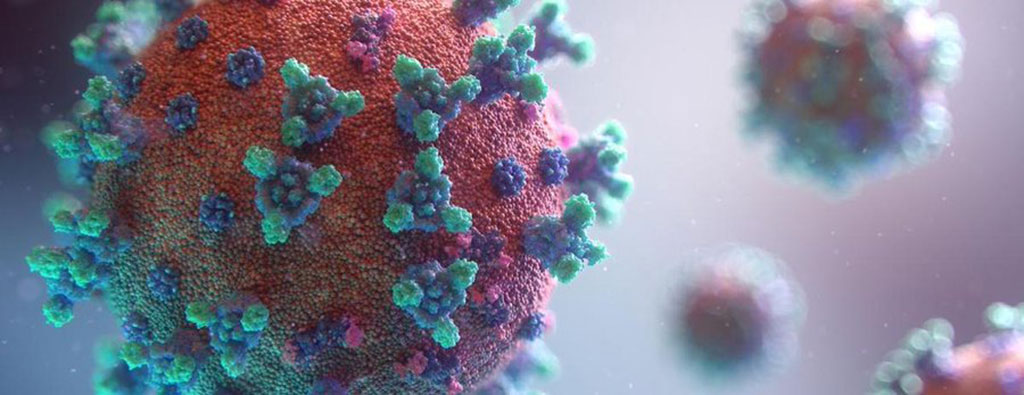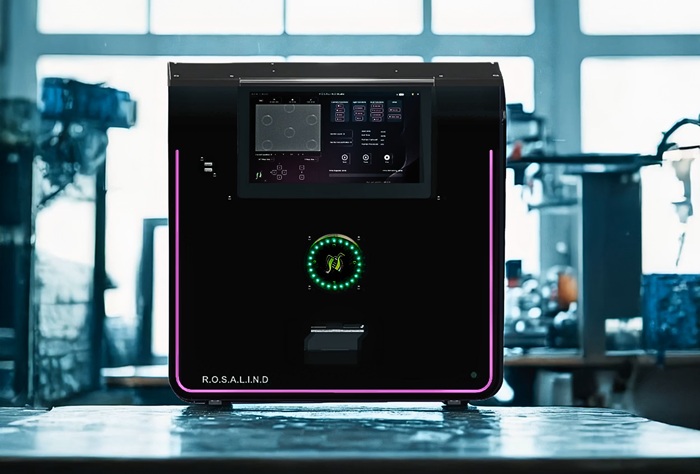Future COVID-19 Tests Could Be Based on Biomarkers and Molecular Profiles of Individuals
|
By LabMedica International staff writers Posted on 23 Oct 2020 |

Illustration
A new study has shown how variations in SARS-CoV-2 host gene expression can be linked to variations in COVID-19 susceptibility and symptom severity. This could pave the way for better medical tests based on biomarkers and molecular profiles of individuals, to accommodate these variations in monitoring virus transmission and disease pathology, which helps guide mitigation and treatment options.
People have different susceptibilities to the SARS-CoV-2 virus and develop varying degrees of fever, fatigue, and breathing problems - common symptoms of the illness. Scientists at the University of California, Riverside (Riverside, CA, USA) and University of Southern California (Los Angeles, CA, USA) may have an answer to explain this variation. The scientists have shown for the first time that the observed COVID-19 variability may have underlying molecular sources. The finding could help in the development of effective prophylactic and therapeutic strategies against the disease.
The SARS-CoV-2 virus hijacks human host molecules for fusion and virus replication, attacking human cellular functions. These human host molecules are collectively called SARS-CoV-2 host genes. The scientists systematically analyzed SARS-CoV-2 host gene expression, their variations, and age- and sex-dependency in the human population using large-scale genomics, transcriptomics, and proteomics. They first found similarity of host gene expression is generally correlated with tissue vulnerability to SARS-CoV-2 infection. Among the six most variably expressed genes in the population they identified ACE2, CLEC4G, and CLEC4M, which are known to interact with the spike protein of SARS-CoV-2.
Higher expression of these genes likely increases the possibility of being infected and of developing severe symptoms. Other variable genes include SLC27A2 and PKP2, both known to inhibit virus replication; and PTGS2, which mediates fever response. The scientists also identified genetic variants linked to variable expression of these genes. According to them, the expression profiles of these marker genes may help better categorize risk groups. In addition to identifying the most variable SARS-CoV-2 host genes, results from the study suggest genetic and multiple biological factors underlie the population variation in SARS-CoV-2 infection and symptom severity. Next, the researchers plan to further analyze large scale genotypes and transcriptome data of COVID-19 patients when made available and to refine the results for higher association and accuracy.
“Based on biomarkers and molecular profiles of individuals, one would hope to develop better medical tests to accommodate these variations in monitoring virus transmission and disease pathology, which helps guide mitigation and treatment options,” said Sika Zheng, an associate professor of biomedical sciences at the UC Riverside School of Medicine, who led the study.
“More comprehensive risk assessment can better guide the early stage of vaccine distribution,” added Zheng. “Tests can also be developed to include these molecular markers to better monitor disease progression. They can also be used to stratify patients to assess and ultimately enhance treatment effectiveness.”
Related Links:
University of California
People have different susceptibilities to the SARS-CoV-2 virus and develop varying degrees of fever, fatigue, and breathing problems - common symptoms of the illness. Scientists at the University of California, Riverside (Riverside, CA, USA) and University of Southern California (Los Angeles, CA, USA) may have an answer to explain this variation. The scientists have shown for the first time that the observed COVID-19 variability may have underlying molecular sources. The finding could help in the development of effective prophylactic and therapeutic strategies against the disease.
The SARS-CoV-2 virus hijacks human host molecules for fusion and virus replication, attacking human cellular functions. These human host molecules are collectively called SARS-CoV-2 host genes. The scientists systematically analyzed SARS-CoV-2 host gene expression, their variations, and age- and sex-dependency in the human population using large-scale genomics, transcriptomics, and proteomics. They first found similarity of host gene expression is generally correlated with tissue vulnerability to SARS-CoV-2 infection. Among the six most variably expressed genes in the population they identified ACE2, CLEC4G, and CLEC4M, which are known to interact with the spike protein of SARS-CoV-2.
Higher expression of these genes likely increases the possibility of being infected and of developing severe symptoms. Other variable genes include SLC27A2 and PKP2, both known to inhibit virus replication; and PTGS2, which mediates fever response. The scientists also identified genetic variants linked to variable expression of these genes. According to them, the expression profiles of these marker genes may help better categorize risk groups. In addition to identifying the most variable SARS-CoV-2 host genes, results from the study suggest genetic and multiple biological factors underlie the population variation in SARS-CoV-2 infection and symptom severity. Next, the researchers plan to further analyze large scale genotypes and transcriptome data of COVID-19 patients when made available and to refine the results for higher association and accuracy.
“Based on biomarkers and molecular profiles of individuals, one would hope to develop better medical tests to accommodate these variations in monitoring virus transmission and disease pathology, which helps guide mitigation and treatment options,” said Sika Zheng, an associate professor of biomedical sciences at the UC Riverside School of Medicine, who led the study.
“More comprehensive risk assessment can better guide the early stage of vaccine distribution,” added Zheng. “Tests can also be developed to include these molecular markers to better monitor disease progression. They can also be used to stratify patients to assess and ultimately enhance treatment effectiveness.”
Related Links:
University of California
Latest COVID-19 News
- New Immunosensor Paves Way to Rapid POC Testing for COVID-19 and Emerging Infectious Diseases
- Long COVID Etiologies Found in Acute Infection Blood Samples
- Novel Device Detects COVID-19 Antibodies in Five Minutes
- CRISPR-Powered COVID-19 Test Detects SARS-CoV-2 in 30 Minutes Using Gene Scissors
- Gut Microbiome Dysbiosis Linked to COVID-19
- Novel SARS CoV-2 Rapid Antigen Test Validated for Diagnostic Accuracy
- New COVID + Flu + R.S.V. Test to Help Prepare for `Tripledemic`
- AI Takes Guesswork Out Of Lateral Flow Testing
- Fastest Ever SARS-CoV-2 Antigen Test Designed for Non-Invasive COVID-19 Testing in Any Setting
- Rapid Antigen Tests Detect Omicron, Delta SARS-CoV-2 Variants
- Health Care Professionals Showed Increased Interest in POC Technologies During Pandemic, Finds Study
- Set Up Reserve Lab Capacity Now for Faster Response to Next Pandemic, Say Researchers
- Blood Test Performed During Initial Infection Predicts Long COVID Risk
- Low-Cost COVID-19 Testing Platform Combines Sensitivity of PCR and Speed of Antigen Tests
- Finger-Prick Blood Test Identifies Immunity to COVID-19
- Quick Test Kit Determines Immunity Against COVID-19 and Its Variants
Channels
Clinical Chemistry
view channel
Noninvasive Blood-Glucose Monitoring Method to Replace Finger Pricks for Diabetics
People with diabetes often need to measure their blood glucose multiple times a day, most commonly through finger-prick blood tests or implanted sensors. These methods can be painful, inconvenient, and... Read more
POC Breath Diagnostic System to Detect Pneumonia-Causing Pathogens
Pseudomonas aeruginosa is a major cause of hospital-acquired and ventilator-associated pneumonia, particularly in lung transplant recipients and patients with structural lung disease. Its ability to form... Read moreMolecular Diagnostics
view channel
Rapid Diagnostic Breakthrough Simultaneously Detects Resistance and Virulence in Klebsiella Pneumoniae
Antibiotic resistance is a steadily escalating threat to global healthcare, making common infections harder to treat and increasing the risk of severe complications. One of the most concerning pathogens... Read more
DNA Detection Platform Enables Real-Time Molecular Detection
A next-gen DNA detection platform enables real-time molecular detection by detecting nucleic acids directly without enzymes or thermocyclers, thereby slashing costs, reducing complexity, and boosting reliability... Read moreHematology
view channel
MRD Tests Could Predict Survival in Leukemia Patients
Acute myeloid leukemia is an aggressive blood cancer that disrupts normal blood cell production and often relapses even after intensive treatment. Clinicians currently lack early, reliable markers to predict... Read more
Platelet Activity Blood Test in Middle Age Could Identify Early Alzheimer’s Risk
Early detection of Alzheimer’s disease remains one of the biggest unmet needs in neurology, particularly because the biological changes underlying the disorder begin decades before memory symptoms appear.... Read more
Microvesicles Measurement Could Detect Vascular Injury in Sickle Cell Disease Patients
Assessing disease severity in sickle cell disease (SCD) remains challenging, especially when trying to predict hemolysis, vascular injury, and risk of complications such as vaso-occlusive crises.... Read more
ADLM’s New Coagulation Testing Guidance to Improve Care for Patients on Blood Thinners
Direct oral anticoagulants (DOACs) are one of the most common types of blood thinners. Patients take them to prevent a host of complications that could arise from blood clotting, including stroke, deep... Read moreImmunology
view channel
Blood Test Could Identify Colon Cancer Patients to Benefit from NSAIDs
Colon cancer remains a major cause of cancer-related illness, with many patients facing relapse even after surgery and chemotherapy. Up to 40% of people with stage III disease experience recurrence, highlighting... Read moreBlood Test Could Detect Adverse Immunotherapy Effects
Immune checkpoint inhibitors have transformed cancer treatment, but they can also trigger serious immune-related adverse events that damage healthy organs and may become life-threatening if not detected early.... Read moreMicrobiology
view channel
Breakthroughs in Microbial Analysis to Enhance Disease Prediction
Microorganisms shape human health, ecosystems, and the planet’s climate, yet identifying them and understanding how they are related remains a major scientific challenge. Even with modern DNA sequencing,... Read more
Blood-Based Diagnostic Method Could Identify Pediatric LRTIs
Lower-respiratory tract infections (LRTIs) are a leading cause of illness and death worldwide, and pneumonia is the leading infectious cause of death in children under five, claiming the lives of over... Read morePathology
view channel
AI Tool Simultaneously Identifies Genetic Mutations and Disease Type
Interpreting genetic test results remains a major challenge in modern medicine, particularly for rare and complex diseases. While existing tools can indicate whether a genetic mutation is harmful, they... Read more
Rapid Low-Cost Tests Can Prevent Child Deaths from Contaminated Medicinal Syrups
Medicinal syrups contaminated with toxic chemicals have caused the deaths of hundreds of children worldwide, exposing a critical gap in how these products are tested before reaching patients.... Read more
Tumor Signals in Saliva and Blood Enable Non-Invasive Monitoring of Head and Neck Cancer
Head and neck cancers are among the most aggressive malignancies worldwide, with nearly 900,000 new cases diagnosed each year. Monitoring these cancers for recurrence or relapse typically relies on tissue... Read moreTechnology
view channel
Machine Learning Models Diagnose ALS Earlier Through Blood Biomarkers
Amyotrophic lateral sclerosis (ALS) is a rapidly progressive neurodegenerative disease that is notoriously difficult to diagnose in its early stages. Early symptoms often overlap with other neurological... Read more
Artificial Intelligence Model Could Accelerate Rare Disease Diagnosis
Identifying which genetic variants actually cause disease remains one of the biggest challenges in genomic medicine. Each person carries tens of thousands of DNA changes, yet only a few meaningfully alter... Read moreIndustry
view channel
BD and Penn Institute Collaborate to Advance Immunotherapy through Flow Cytometry
BD (Becton, Dickinson and Company, Franklin Lakes, NJ, USA) has entered into a strategic collaboration with the Institute for Immunology and Immune Health (I3H, Philadelphia, PA, USA) at the University... Read more
























